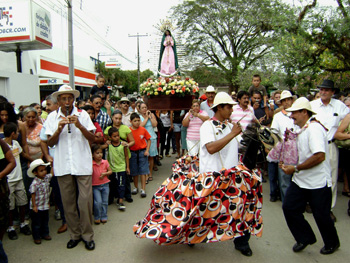The town of Nicoya is preparing a great celebration to honor its patron saint, the Virgin of Guadalupe, along with the Yegüita Dance, which is held every December 12th to commemorate the origins and traditions that the Chorotega Indians left. The religious celebration includes several activities that bring residents, families and visitors together, embellishing the town with faith through one of the most deeply rooted traditions that characterizes Guanacaste's religious folklore.
The Yegüita's legend says that: "On December 12th, right after the Mass devoted to the Virgin of Guadalupe was held, a group of devout followers were returning to their huts near the top of Cerro Las Cruces, in Nicoya, when two very drunken brothers had an argument and started fighting with their sharp machetes. Faced with this impending tragedy, the churchgoers began praying to the Virgin of Guadalupe, begging her to stop the bloody fight so that none of the brothers would die".
"Suddenly, as if by magic, a small mare, or yegüita, appeared out of nowhere, kicking and biting until she separated the contenders, making them desist from their fight and madness. The faithful devotees fell to their knees, fervently thanking the Virgin's miracle. Meanwhile, just as it had appeared, the yegüita disappeared into the nearby bushes and forest".
The Indians considered this a true miracle and for this reason, to commemorate the miracle at the Cerro Las Cruces, during processions held in Nicoya for the Virgin of Guadalupe, a wooden horse performs a very particular dance to the sound of whistles and drums.
Mexico's Virgin Arrives in Nicoya
Our Lady of Guadalupe manifested herself to Juan Diego, an indigenous peasant, over the hills of Tepeyac, Mexico on four occasions, her last appearance being on December 12th, 1531. In 1544, as a result of her appearance in Mexico, priests introduced the devotion for the Virgin of Guadalupe among the Chorotega Indians, who were natives of Mexico that had settled for over two centuries in Nicoya.
By this time, the Chorotegas had just adopted the Catholic religion and the Spanish language and at the beginning, the celebration focused mostly on religion, on preparing meals and drinks and on the processions.
Many years before a celebration honoring the Virgin of Guadalupe was held, Indians worshiped the sun, the moon, fire, water and the wind. In their rituals they emphasized paganism consisting of human sacrifices, shedding the blood of those sacrificed over all who participated in the Feast of the Sun, which was held to thank the Sun God for their crops and prosperity. |
|
 |
| |
|
| |
 |
| |
|
| |
 |
| |
|
| |
 |
Priests, however, were frightened by these sacrifices and, taking advantage of the appearance of the Virgin of Guadalupe to the Indian peasant, Juan Diego, they slowly introduced their beliefs so that the Chorotegas replaced the Feast of the Sun with a celebration in honor of Our Lady of Guadalupe, which the Indians did with great affection.
After the miracle granted by the Virgin, and with the Yegüita Dance already a part of their festivities, it became a tradition among the Chorotegas to solve their disputes without wearing a shirt, using knifes made out of tapir leather, hurting each other until they bled, to the sound of Indian music. When the Yegüita deemed appropriate, it intervened in order to separate them. This tradition was known as the "Chilillada", but was abolished around 1914 since Father Jose Maria Velazco considered it cruel and bloody. The "Chilillada" tradition was then replaced by a small image of the Virgin of Guadalupe called the Doll (la Muñeca).
The Yegüita, also known as "el caballito", consists of a horse's head made out of cedar and painted black, attached to a ring made of vines and with a rope tail or mane. It is dressed with colorful fabrics in the form of a skirt. Thus, the loving devotees carry their own dresses wrapping themselves in its paper and, under a scorching sun, they dance to the sound of the music, bowing to their beloved "patroncita".
Costa Rican historian, Carlos Arauz, explains that, "Originally, the native Indians were the ones who held the celebration; currently this is done by the mestizos that make up the Nicoya community, who have become a part of the festivities to the extent that the celebration is now part of Nicoya's residents and all its visitors, since the Virgin of Guadalupe holds great devotion, she is the American Empress".
The Virgin, the Sun and their Brotherhood
Nowadays, the Nicoya brotherhood is the only one that is still planting and growing its own crops. Devoted stockbreeders, for example, donate livestock, and whatever they don't have is received through donations, all for the Virgin of Guadalupe's celebration.
Arauz continues explaining how this festivity is perceived as a big sun feast that lays within; the heritage, the Chorotega trace, all because on December 12th, at the Nicoya brotherhood, there is a swarm of people dancing, eating and doing different things, all at once, with great revelry, resembling a great feast, the feast of the sun.
"The Virgin of Guadalupe's tradition will always be one of the main symbols of our ancestors and of the respect and admiration that our spirits must eternally profess for the transcendent and noble things in life", concluded Arauz.
With this splendid celebration held every December 12th, the Nicoyanos manifest their affection for their origins, traditions and beliefs, which were inherited from indigenous ancestors and which are now shown through a special cultural tribute for the Virgin of Guadalupe.
|

